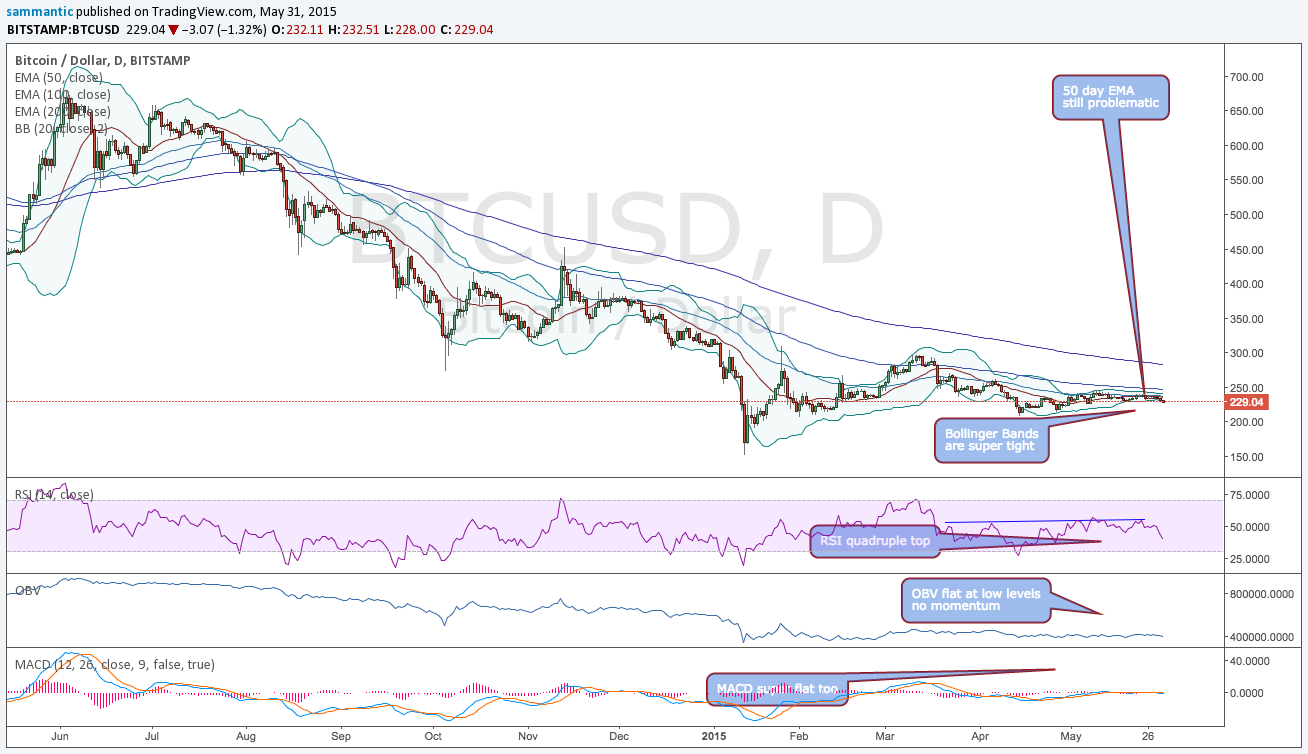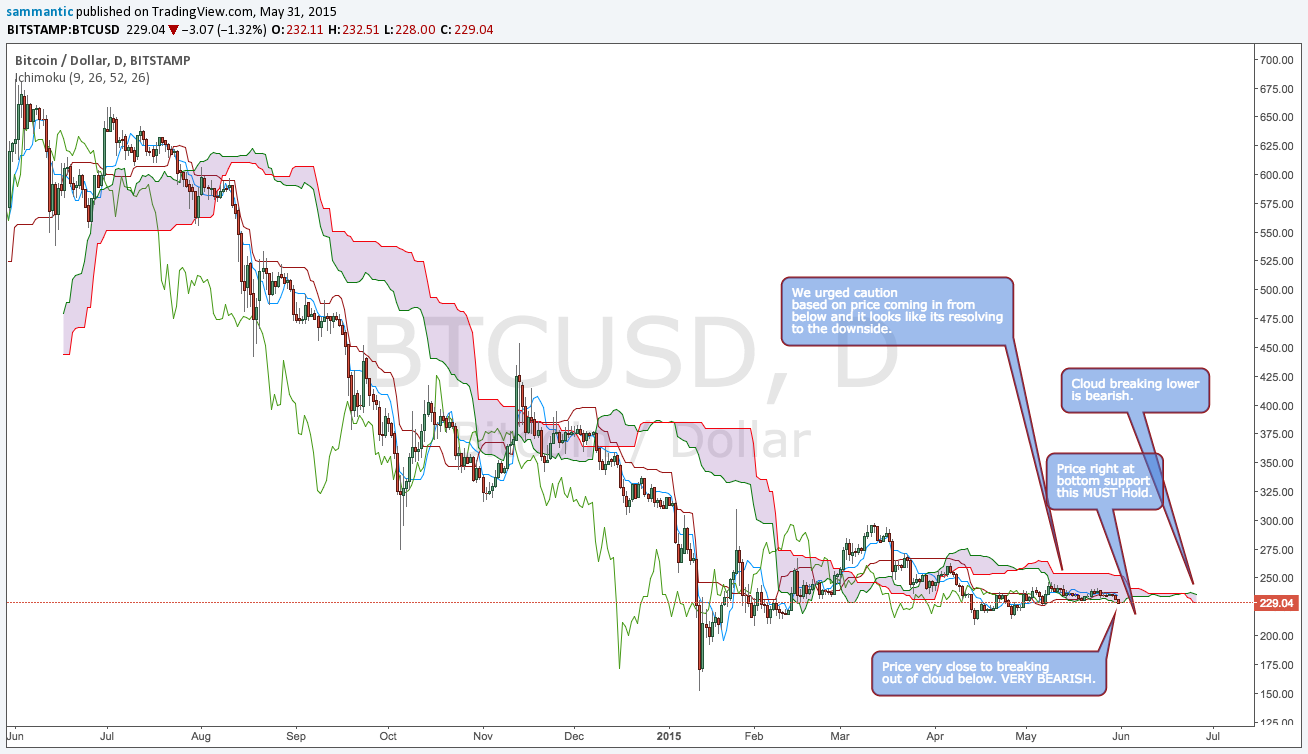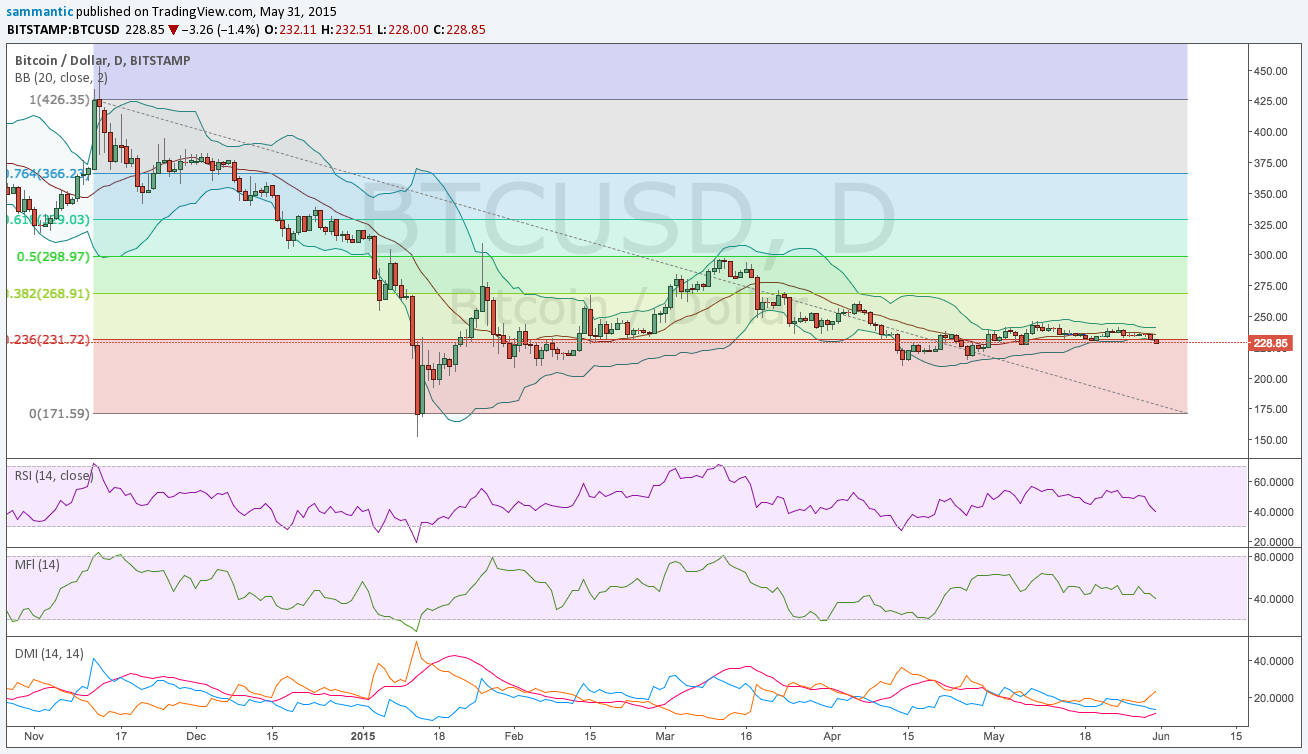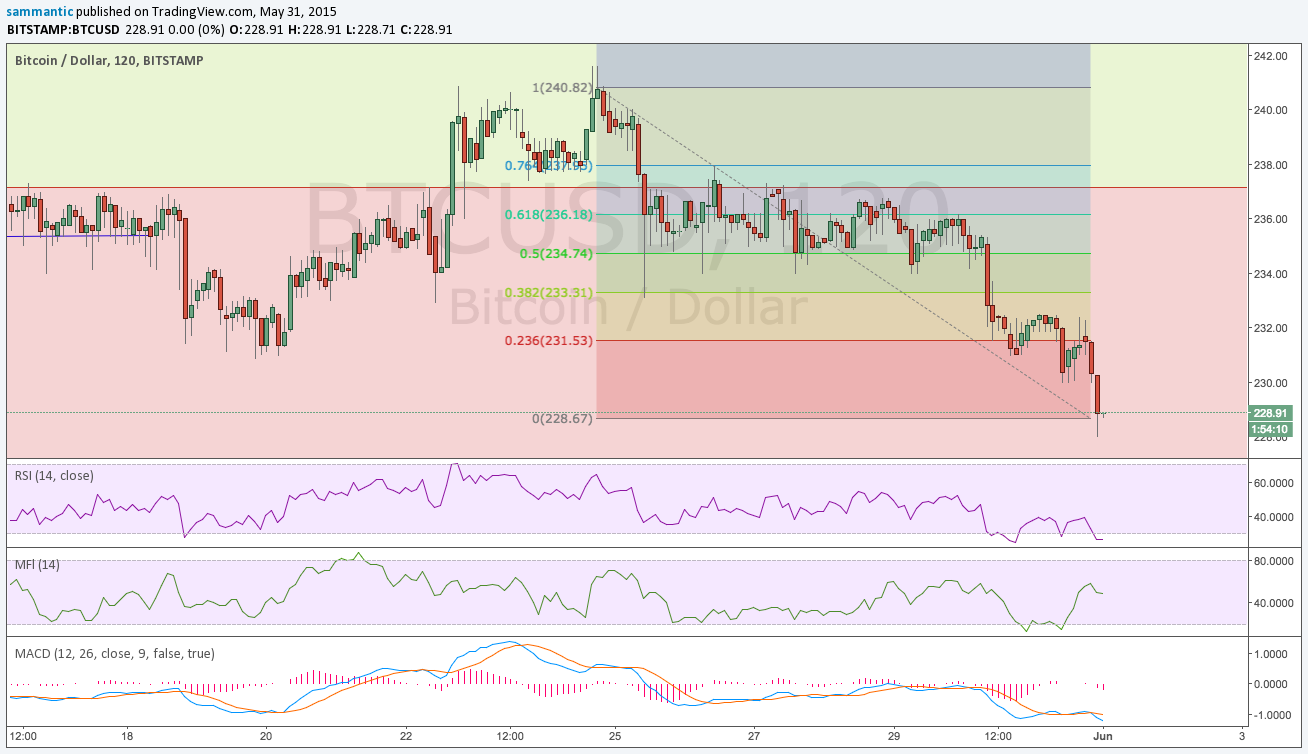For timely updates on price updates, follow me @sammantic.
Price at the time this article was written was: US$228.59
Last week’s article began with:
“Resolution of this range should come soon and it could be a big move since there has been less and less on-exchange liquidity in recent months.”
Technically, we are starting to get a resolution, and unfortunately it is looking like a downside one. The price has broken below some significant levels and looks like it's going to test some very important levels below. The 50-day EMA (exponential moving average) has been a massive wall and it looks like the price has run out of energy trying to get and stay above it.
Now a big test is coming, as price has broken below US$231, which has been mentioned in many previous articles as an area that needed to hold. Look for US$220 and the massive support area of US$210 to be tested, and perhaps in short order. It looks like more bad news in the exchange (OkCoin and Igot) space has the price on the defensive and ready to move out of this tight range.
Long Term
The 1-year (long term) chart for bitcoin remains bearish. The price remains below all three of its EMAs. The battleground around the 50-day EMA looks resolved and the move is lower. Major resistance is now the 50-day EMA at approximately ~US$237, but should continue lower. Price has been rejecting higher levels for well over a month.
All three EMAs are super tight and compressing on top of each other. The same applies for the Bollinger Bands. The 50 (US$237) and 100 (US$247) have been giving signals of a move and the fact that price has not been able to get above the 50-day shows the move that has been waited for is lower.
The Bollinger Bands could not be tighter and have not been in the chart below for the course of a year. This has been another sign that a move was coming and it appears ready to resolve. The wound-up clock that is the Bollinger Bands and the EMAs should provide a fairly big move. How big, we shall find out soon. Based on how tight they both are, it should be a significant price move.
The Relative Strength Index (RSI) looks to have put in a quadruple top and has not had the strength to move to higher levels. It is now heading downward along with price. Also note that the MACD (moving average convergence divergence) has crossed back below the zero line and has remained flat for an extended period. This also could also unwind fast with downside momentum gaining steam. All of this has happened on very low volume. These are no signs of a trend change.
On Balance Volume (OBV) has been added as well and has been flat for months. This indicator has been added to see if it may be time to get bullish. The theory behind OBV is that volume precedes price and if there is going to be a big move up, or a reversal in price, it would be seen in volume. Still not much in the way of volume, but it’s time to watch and see, as every other indicator along with the price is showing more downside should be expected.

Ichimoku Clouds
The 1-year Ichimoku (cloud chart) looks ready to crack. Price has entered from below the bottom of the cloud and now looks ready to break the lower bound of the cloud. ~US$229 is now providing big support for the price as it is the lower bound of the cloud.
When looking at the clouds, it’s important to remember from which direction price enters the cloud. Since it entered from below, the cloud should continue to be resistance for the price, and ~US$255 (which is the top of the cloud) will be a major test, if price ever gets there.
The cloud ahead is forming a cloud lower and is starting to sag with force. This will cause additional pressure on the price.
The Chikou Span (Lagging Line) has never entered the cloud, and the Tankan Sen (Conversion Line) and the Kijun Sen (Base Line) look ready to come out of the cloud with a downside resolution. All signs are pointing to breaking out of the cloud and heading lower.
Last week we wrote: “The price is spending a lot of time not getting anywhere. It’s starting to look like it’s going to be difficult for the price to stay above the lower bound of the cloud. For further definitions of what is being discussed, please refer to this previous post on Ichimoku cloud charts.” This looks to be the case.

Intermediate-Term Trend
We said last week:
“Using Fibonacci retracements from an intermediate-term price high of US$427 recorded back in mid-November, we see that the price is above the support at ~US$230. Another Fibonacci retracement was run from the mid-March highs to look for additional support and resistance areas. ~US$233 and ~US$230 are the next support areas, with ~US$230 being a big one as it confirms the lower bound of the Ichimoku cloud. That makes it an important area to hold.”
This area has now broken. Expect tests of minor support levels below (like ~US$220), but the US$210-215 looks like it will provide MAJOR support and if it doesn’t hold, price will probably test the lows made in early January.
The RSI topped out a few weeks back and confirms the price heading lower. The Money Flow Index is also confirming this.
Included is the Directional Movement Index (DMI), which looks at buying and selling pressures. The blue line indicates buying pressure, the red line indicates selling pressure, and the orange line is the ADX, which indicates the strength or weakness of a trend.
Buying Pressure and Selling Pressure continue to fall and are both below the ADX. The ADX has crossed over the Buying Pressure Line, which could initiate a sell signal because this means buying pressure has declined and the sellers might start to attack. Selling Pressure looks ready to cross over Buying Pressure and the ADX is heading higher, which indicates price is ready to move. If Selling Pressure crosses over, it will lead to a big move down.
The Bollinger Bands in the intermediate time frame are even tighter and the price has fallen out of the lower Bollinger Band. This should mean more weakness in price, and perhaps a bigger move may accelerate. Again, unfortunately, these are bearish signals.

Short-Term Trend
Looking at the short-term trend (May 24 price high of ~US$240) using Fibonacci retracements, US$235 and US$231 are really big areas and have broken. Price is at its lowest point since hitting the $240 high. The US$225 and US$221 come into play, but will probably be stops on the way to testing the ~US$210 level. The RSI is oversold currently and the Money Flow is heading lower. Price may bounce short term, but those big levels below should be tested. The MACD is also on a sell signal.

Big Move Imminent
Bitcoin is still in a primary downtrend and with all the tension in the moving averages and Bollinger Bands, a big move looks like it has finally begun.
The price didn’t hold above US$235 and US$230. Momentum and volume are beginning to pick up to the downside. This is not what the bulls wanted to see. The 50-day EMA has now become very big resistance as price has continuously failed to stay above this mark and now is breaking decisively below it.
A retest of the ~US$210 area continues to look like a possibility.
Disclaimer: Articles regarding the potential movement in cryptocurrency prices are not to be treated as trading advice. Neither Cointelegraph, nor the author assumes responsibility for any trade losses, as the final decision on trade execution lies with the reader. Always remember that only those in possession of the private keys are in control of the money.
